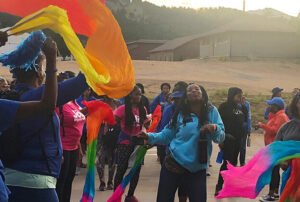
February 28, 2018; Artsy
Artists often choose to engage in projects that call attention to social issues or advocate for policy changes. Increasingly, however, artists are being cultivated for such projects by nonprofits aligned with the environment, immigration, healthcare, homelessness, and other issues. Sometimes, these nonprofits are looking to make their case with the public by telling their stories through a different lens. Other times, they seek the attention of the broader arts community, including gallerists and collectors, who might become new donors. And once in a while, if the stars align just so, the nonprofits might accomplish both goals even as they help the artists to find new audiences.
Writing for Artsy, Anna Louie Sussman offers several examples of national as well as local nonprofits that have partnered with artists or arts groups to advance a particular cause:
Sign up for our free newsletters
Subscribe to NPQ's newsletters to have our top stories delivered directly to your inbox.
By signing up, you agree to our privacy policy and terms of use, and to receive messages from NPQ and our partners.
- The National Resources Defense Council (NRDC) has, for the last six years, had a booth at Expo Chicago, a major global art and culture gathering. NRDC partners with artists to highlight environmental issues. For example, for the 2017 event, the Chicago-based collective Luftwerk created a project called “White Wanderer” that featured “actual recordings of the sounds and frequencies of melting and moving glaciers in a booth fitted with shards of mirror that evoked the shattering of the Larsen C ice shelf in Antarctica, which just a few months before Expo Chicago was held, broke off into the Weddell Sea.” Anyone who stopped to visit the booth not only had the type of high-end arts experience they might have expected at Expo Chicago, but also had the opportunity to visualize—and even hear—climate change in a new way, to interact with the artists as well as with environmental advocates from NRDC, and to consider making a donation to the environmental nonprofit.
- Planned Parenthood Los Angeles (PPLA) inspired local gallerists to start a separate nonprofit called Sexy Beast to engage artists in supporting PPLA. Sexy Beast presents an annual gala and art auction. In addition, for 2018, the Sexy Beast website says that the organization “will launch a series of exclusive art objects and editions, and host satellite events that mobilize the art, design, food and fashion communities to maximize the benefit to PPLA.”
- The Coalition for the Homeless in New York City solicits donations of artwork for auction from artists. Since 1995, the nonprofit has raised more than $10 million through arts-related fundraising to support direct services (i.e., warm meals, job training, housing) and advocacy work for the city’s homeless population.
- Human Rights Watch (HRW) has also had exhibit space at Expo Chicago over the last several years, and they have found interactive art exhibitions to be especially effective at engaging visitors in their work. In 2016, they featured “34,000 Pillows,” a project by artist collaborative Diaz Lewis aimed at producing that many pillows to highlight “the number of beds U.S. Immigration and Customs Enforcement (ICE) maintained in 2016 for immigrants detained across the country.” Each pillow—some of which are made from clothing donated by detainees—sells for $159, “the daily cost to taxpayers for detaining one person.”
As HRW officer Rachel Shrock observed, “Art is able to transform and materialize the issue in a way that words often cannot communicate, and in an instantaneous way. The look on peoples’ faces when we explain about the 34,000 people detained each day in the US, and the cost of that. You could just see the way it affected them, thinking about what it means to lay your head down on a pillow, how many pillows that is and how many human beings that is. It’s very different than reading a text on a wall.”
One question not addressed in the Artsy article—interestingly, since it is written from an arts perspective—is whether or not, and if so, how, various artists are being compensated for projects they support that raise awareness of social causes. A brief online search indicates that “White Wanderer” was funded in part by a Kickstarter campaign, and in part by NRDC and the University of Chicago. The 34,000 Pillows project, which SanctuaryCity.org says has to date raised more than $35,000, is both an extraordinary project and an extraordinarily labor-intensive one; it is not clear if those making the pillows are being compensated in any way for their time and materials, or if the labor and materials are all being donated. The same question applies to those artists involved with Sexy Beast and with the Coalition for the Homeless; the latter used to begin its fundraising event with a tour of artist studios in SoHo, which certainly might have helped to sell some art, but has since evolved into a more traditional gala with a live art auction, including works donated by high-profile contemporary artists.
NPQ’s new podcast partner, Tiny Spark, is currently developing an investigative report on this topic of artists being asked to donate their work for charitable fundraising causes; stay tuned for an upcoming episode. In the meantime, we welcome artists and arts collectives to weigh in on this issue: How do you feel about donating your work (and your time, and your materials) to advance social causes and nonprofits organizations you care about?—Eileen Cunniffe












